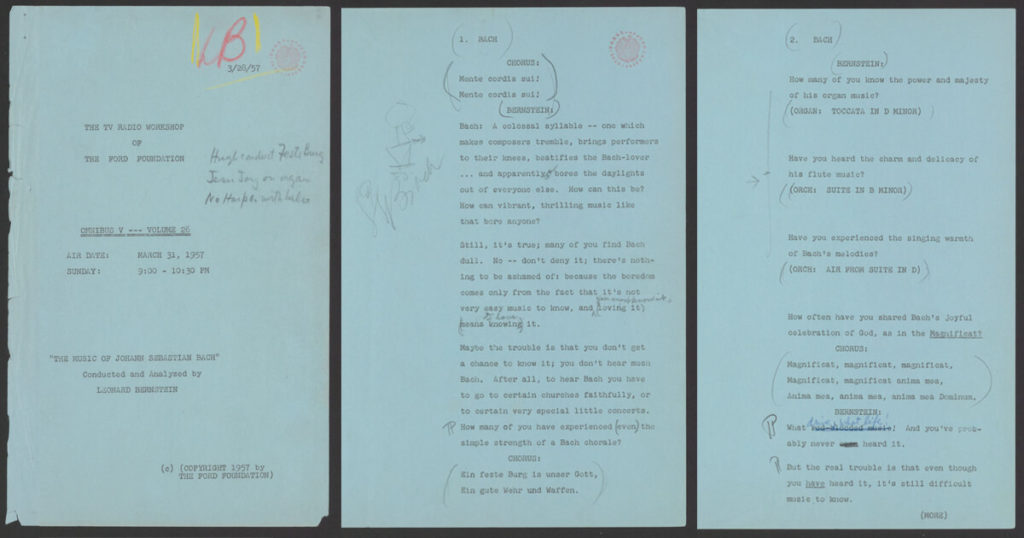
Not long ago, Turner Classic Movies aired several episodes of the 1950s television show Omnibus in which that most engaging and passionate of teachers, Leonard Bernstein, aided by singers and instrumentalists, lectured on various musical subjects. The aim of Omnibus was to enrich the cultural life of the American public, and as such, it represented an early attempt at producing programming that was entertaining as well as educational. If you had tuned in to those Sunday afternoon and evening shows, you might have encountered the likes of Frank Lloyd Wright or William Saroyan or Orson Welles. Bernstein hosted seven programs (forerunners to his legendary Young People’s Concerts with the New York Philharmonic), which covered topics such as “What Makes Opera Grand,” “Beethoven’s Fifth Symphony,” and “The American Musical Comedy”—their illuminating content belying these somewhat sober titles. I happened upon the Bernstein mini-marathon when it was halfway over, though I did manage to add a few episodes to my DVR queue. A few evenings ago, I happily settled in to watch “The Music of J. S. Bach”—the most inspiring hour I’ve spent in front of the television in ages.
If you’ve seen any of the Young People’s Concerts, you know that Bernstein the Teacher was every bit as compelling as Bernstein the Conductor and Bernstein the Composer. He held you in his thrall, commanding the material, marshalling evidence, leading the viewer step by step into the mysteries and complexities of musical architecture—without ever condescending to his audience, or dumbing things down. He was both highbrow and egalitarian, as willing to invoke Elvis or the Beatles as he was Brahms or Tchaikovsky. This was a man, after all, who described Berlioz’s Symphonie Fantastique as one long musical acid trip to a concert hall filled with children. (Try getting away with that today.)
I like to imagine that there was an earlier, halcyon age of musical literacy in this country—when more people could read a score or play an instrument, when the popular culture was suffused with classical music to a greater extent than it is today. Yet what I find most amazing about the Omnibus episode on Bach (it aired in 1957) is the disclaimer Bernstein offers at the outset. Not only does he acknowledge that his audience may find Bach’s music utterly boring, he concedes that most people would have heard very little of it. With the help of his musicians, he proceeds to demonstrate some of this exotic fare—a few lines from the Magnificat, the opening to the Toccata and Fugue in D minor—these now-familiar fragments presented as if they were rare species of butterflies flitting across our ken. This was just prior to the early music revival, which began in the late ’50s, and well before the full flourishing of the period-instrument movement a few decades later. At any rate, Bernstein assures us that the only thing really required, if we are to fall under Bach’s spell, is careful attention, study, and familiarity with the music’s materials. “Once you do get to know Bach’s music well enough to love it,” he adds, “you’ll find you love him more than any other composer.”
At the heart of Bernstein’s lecture is an explanation of “that frightening bugaboo, counterpoint.” “Why,” he asks, “are people so scared of this word?” He then demystifies the concept, showing how several seemingly independent lines sound in isolation and in expert combination, working melodically and harmonically. Harmony and counterpoint fused together: this is the essence of Bach’s genius. Bernstein subsequently explores the canon and the fugue—“the ultimate expression of counterpoint”—playing examples from Bach’s chorales, his explications rich with metaphor—“it’s something like a smoothly flowing river whose course is dotted with islands. The river is the main musical material, while the islands are the phrases, the separate phrases of the chorale melody, isolated one from the other. That’s where the counterpoint comes in, the land and the water together.”
Now, he persuades us, we’re ready to tackle that glorious, sprawling masterpiece that had turned him onto Bach many years before: the St. Matthew Passion. He had been largely indifferent to the composer until a detailed study of that oratorio roused him from his doldrums. Discussing the opening chorus, Bernstein breaks down the dense music into its constituent parts, and he delves with great panache into other parts of the work, explaining its dramatic and mystical content, as well as the brilliant ways Bach “paints” his texts with sound. Listen, Bernstein tells us, to the way the strings form a soft halo-like glow around Jesus’s words—up until the moment of the crucifixion, that is. Then, the voice of Jesus is unadorned, and it’s as if Bach were stripping him of his divinity, showing us Jesus in his most vulnerable, and human, state. When Bernstein turns to the magnificent soprano and alto duet with chorus, “Thus hath my Jesus now been taken,” he explains each strand of this “contrapuntal lament,” this striking passage full of emotion—furious, roiling, dramatic. Hear this chorus once, Bernstein promises, and “you can never again say that counterpoint is dull. This is drama at the boiling point.” And so it is.
“Bach was a man … not a god,” Bernstein concludes, “but he was a man of God. His godliness shines through all this music, from first to last.” Even the secular scores, Bernstein argues, are religious in spirit and intent, and he asks us to explore as much of this music as we can: “songs, dances, suites, partitas, sonata, toccatas, preludes, fugues, cantatas, oratorios, masses, passions, fantasies, concertos, chorales, variations, motets, passacaglias—the white hot creations of 50 ceaseless years.” Let’s say that I was suitably exhilarated. After all, the mark of a great teacher is the ability not only to initiate the unaware but also to reveal new vistas in the works we already know well, to make us hunger for more.

